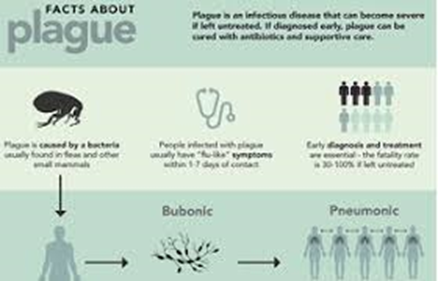Plague
Overview
Plague is a serious
bacterial infection that's transmitted primarily by fleas. The organism that
causes plague, Yersinia pestis, lives in small rodents found most commonly in
rural and semirural areas of Africa, Asia and the United States. The organism is
transmitted to humans who are bitten by fleas that have fed on infected rodents
or by humans handling infected animals.
Known as the Black Death
during medieval times, today plague occurs in fewer than 5,000 people a year
worldwide. It can be deadly if not treated promptly with antibiotics. The most
common form of plague results in swollen and tender lymph nodes — called buboes
— in the groin, armpits or neck. The rarest and deadliest form of plague
affects the lungs, and it can be spread from person to person.
Symptoms
Plague is divided into three
main types — bubonic, septicemic and pneumonic — depending on which part of
your body is involved. Signs and symptoms vary depending on the type of plague.
Bubonic plague
Bubonic plague is the most common
variety of the disease. It's named after the swollen lymph nodes (buboes) that
typically develop in the first week after you become infected. Buboes may be:
Situated in the groin,
armpit or neck
About the size of a chicken
egg
Tender and firm to the touch
Other bubonic plague signs
and symptoms may include:
Sudden onset of fever and
chills
Headache
Fatigue or malaise
Muscle aches
Septicemic plague
Septicemic plague occurs
when plague bacteria multiply in your bloodstream. Signs and symptoms include:
Fever and chills
Extreme weakness
Abdominal pain, diarrhea and
vomiting
Bleeding from your mouth,
nose or rectum, or under your skin
Shock
Blackening and death of
tissue (gangrene) in your extremities, most commonly your fingers, toes and
nose
Pneumonic plague
Pneumonic plague affects the
lungs. It's the least common variety of plague but the most dangerous, because
it can be spread from person to person via cough droplets. Signs and symptoms
can begin within a few hours after infection, and may include:
Cough, with bloody mucus
(sputum)
Difficulty breathing
Nausea and vomiting
High fever
Headache
Weakness
Chest pain
Pneumonic plague progresses
rapidly and may cause respiratory failure and shock within two days of
infection. Pneumonic plague needs to be treated with antibiotics within a day
after signs and symptoms first appear, or the infection is likely to be fatal.
When to see a doctor
If you begin to feel ill and
have been in an area where plague has been known to occur, seek immediate
medical attention. You'll need treatment with medication to prevent serious
complications or death.
In the United States, plague
has been transmitted to humans in several western and southwestern states —
primarily New Mexico, Arizona, California and Colorado. Worldwide, plague is
most common in rural and semirural parts of Africa (especially the African
island of Madagascar), South America and Asia.
Causes
The plague bacteria,
Yersinia pestis, is transmitted to humans through the bites of fleas that have
previously fed on infected animals, such as:
Rats
Mice
Squirrels
Rabbits
Prairie dogs
Chipmunks
Voles
The bacteria can also enter
your body if a break in your skin comes into contact with an infected animal's
blood. Domestic cats and dogs can become infected with plague from flea bites
or from eating infected rodents.
Pneumonic plague, which
affects the lungs, is spread by inhaling infectious droplets coughed into the
air by a sick animal or person.
Risk factors
The risk of developing
plague is very low. Worldwide, only a few thousand people develop plague each
year. However, your plague risk can be increased depending on the area where
you live and travel, your job, and your hobbies.
Location
Plague outbreaks are most
common in rural and semirural areas that are overcrowded, have poor sanitation
and have a high rodent population. The greatest number of human plague
infections occur in Africa, especially the African island of Madagascar. Plague
has also been transmitted to humans in parts of Asia and South America.
In the United States, plague
is rare, but it has been known to occur in several western and southwestern
states — primarily New Mexico, Arizona, California and Colorado.
Job
Veterinarians and their
assistants have a higher risk of coming into contact with domestic cats and
dogs that may have become infected with plague. People who work outdoors in
areas where plague-infected animals are common are also at higher risk of
getting plague.
Hobbies
Camping, hunting or hiking
in areas where plague-infected animals reside can increase your risk of being
bitten by an infected flea.
Complications
Complications of plague may
include:
Death. Most people who
receive prompt antibiotic treatment survive bubonic plague. Untreated plague
has a high fatality rate.
Gangrene. Blood clots in the
tiny blood vessels of your fingers and toes can disrupt blood flow and cause
that tissue to die. The portions of your fingers and toes that have died may
need to be removed (amputated).
Meningitis. Rarely, plague
may cause inflammation of the membranes surrounding your brain and spinal cord
(meningitis).
Prevention
No effective vaccine is
available, but scientists are working to develop one. Antibiotics can help
prevent infection if you're at risk of or have been exposed to plague. Take the
following precautions if you live or spend time in areas where plague outbreaks
occur:
Rodent-proof your home.
Remove potential nesting areas, such as piles of brush, rock, firewood and junk.
Don't leave pet food in areas that rodents can easily access. If you become
aware of a rodent infestation, take steps to control it.
Keep your pets free of
fleas. Ask your veterinarian which flea-control products will work best.
Wear gloves. When handling
potentially infected animals, wear gloves to prevent contact between your skin
and harmful bacteria.
Use insect repellent.
Closely supervise your children and pets when spending time outside in areas
with large rodent populations. Use insect repellent.
Jan Ricks Jennings, MHA, LFACHE
Senior Consultant
Senior Management Services, LLC
JanJenningsBlog.Blogspot.com
412.913.0636 Cell
724.733.0509 Office
March 17, 2022




I never thought I will ever be cure from my Herpes again, I was diagnosed with Genital Herpes since last year July, Until one day I go on a research on the Internet where I saw someone given testimony on how Dr Ogala help him cure his herpes with his natural herbal medicine, i was so surprised when i saw the testimony, and I have to also contact the herbal doctor (Ogala) for help, He sent me his remedy and i was cured completely within 2 weeks of taking the remedy. I am so grateful to this man as he has restored my health and made me a happy person again. Anyone out there who might be facing the same problem or any sexual transmitted disease should kindly contact Dr Ogala on Email: ogalasolutiontemple@gmail.com Or WhatsApp +2349123794867
ReplyDelete